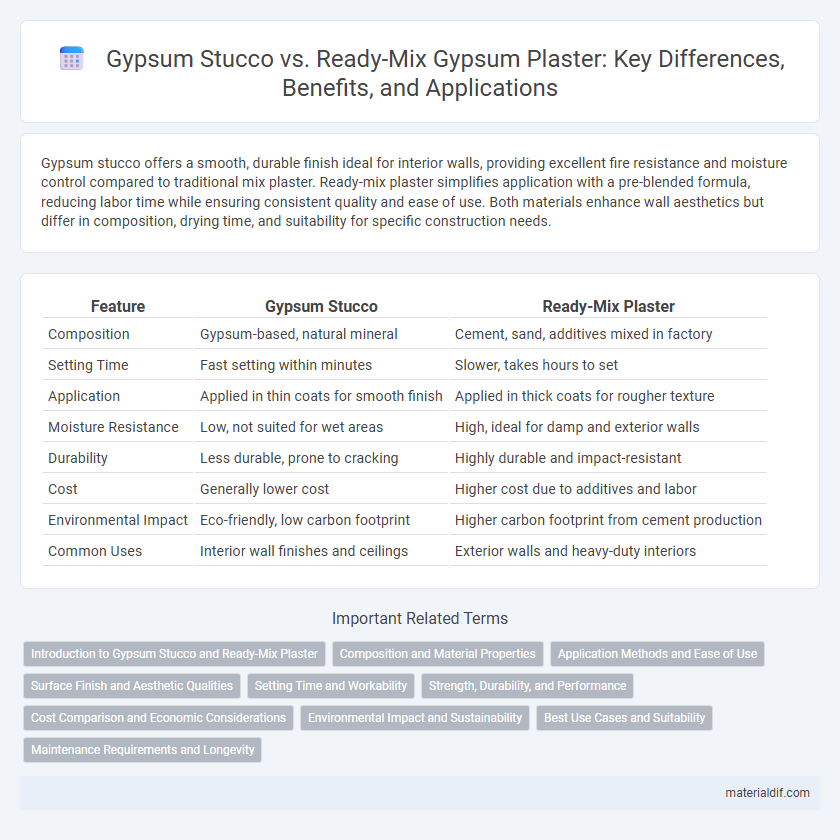Gypsum stucco offers a smooth, durable finish ideal for interior walls, providing excellent fire resistance and moisture control compared to traditional mix plaster. Ready-mix plaster simplifies application with a pre-blended formula, reducing labor time while ensuring consistent quality and ease of use. Both materials enhance wall aesthetics but differ in composition, drying time, and suitability for specific construction needs.
Table of Comparison
| Feature | Gypsum Stucco | Ready-Mix Plaster |
|---|---|---|
| Composition | Gypsum-based, natural mineral | Cement, sand, additives mixed in factory |
| Setting Time | Fast setting within minutes | Slower, takes hours to set |
| Application | Applied in thin coats for smooth finish | Applied in thick coats for rougher texture |
| Moisture Resistance | Low, not suited for wet areas | High, ideal for damp and exterior walls |
| Durability | Less durable, prone to cracking | Highly durable and impact-resistant |
| Cost | Generally lower cost | Higher cost due to additives and labor |
| Environmental Impact | Eco-friendly, low carbon footprint | Higher carbon footprint from cement production |
| Common Uses | Interior wall finishes and ceilings | Exterior walls and heavy-duty interiors |
Introduction to Gypsum Stucco and Ready-Mix Plaster
Gypsum stucco is a plaster material made primarily from gypsum, mixed with sand, cement, and water to create a durable exterior or interior wall coating. Ready-mix plaster combines gypsum with additives and binders in a factory-controlled process, providing a consistent, easy-to-apply mixture that reduces labor and installation time. Both materials offer smooth finishes and moisture resistance, but gypsum stucco is favored for traditional textured surfaces while ready-mix plaster suits modern, fast-track construction needs.
Composition and Material Properties
Gypsum stucco primarily consists of calcined gypsum mixed with sand, water, and fibers, offering superior breathability and faster setting times compared to ready-mix plaster. Ready-mix plaster contains a blend of gypsum, lime, cement, and additives, providing enhanced durability and moisture resistance suitable for exterior applications. The higher calcium sulfate content in gypsum stucco ensures smoother finishes, while the composite nature of ready-mix plaster improves adherence and structural strength.
Application Methods and Ease of Use
Gypsum stucco requires skilled application involving multiple layers and curing times, making it suitable for durable, decorative finishes on exterior walls. Ready-mix plaster offers a more user-friendly approach with pre-mixed consistency, allowing quicker application and less preparation, ideal for interior surfaces. Both materials demand specific techniques, but ready-mix plaster is favored for its ease of use and faster setting time.
Surface Finish and Aesthetic Qualities
Gypsum stucco offers a smooth, fine finish with excellent adhesion, enhancing the aesthetic appeal of both interior and exterior surfaces through its natural whiteness and ability to be painted or decorated easily. Ready-mix plaster provides a consistent texture and faster application time, often with additives that improve durability and workability, resulting in a uniform surface ideal for detailed decorative finishes. Both materials contribute to high-quality surface finishes, but gypsum stucco is preferred for more refined, polished aesthetics, while ready-mix plaster suits projects requiring efficiency and versatility.
Setting Time and Workability
Gypsum stucco typically sets faster than ready-mix plaster, with an average setting time of 20 to 30 minutes, making it ideal for quick applications. Ready-mix plaster offers superior workability and a smoother finish due to its balanced composition of gypsum, lime, and sand, allowing for easier troweling and shaping. The faster setting time of gypsum stucco requires rapid application skills, whereas ready-mix plaster provides greater flexibility for detailed work and extended working time.
Strength, Durability, and Performance
Gypsum stucco offers superior strength and durability compared to ready-mix plaster due to its dense crystal structure that enhances resistance to cracking and weathering. Ready-mix plaster provides flexibility and ease of application but tends to have lower tensile strength, making it less suitable for exterior surfaces exposed to harsh conditions. Performance-wise, gypsum stucco maintains dimensional stability and moisture resistance, ensuring long-lasting finishes in both interior and exterior applications.
Cost Comparison and Economic Considerations
Gypsum stucco generally incurs lower initial costs compared to ready-mix plaster due to its simpler formulation and minimal labor requirements. Ready-mix plaster demands higher upfront expenses because of its premixed convenience and consistent quality, which can reduce long-term maintenance costs. Economic considerations favor gypsum stucco in budget-sensitive projects, while ready-mix plaster offers better value for durability and reduced application time.
Environmental Impact and Sustainability
Gypsum stucco offers superior environmental benefits due to its low-energy production process and high recyclability, reducing carbon footprint compared to ready-mix plaster, which often contains synthetic additives and requires more energy-intensive manufacturing. The natural composition of gypsum allows for better indoor air quality and minimal waste during application, promoting sustainability in construction projects. In contrast, ready-mix plaster's chemical components can contribute to higher VOC emissions and less eco-friendly disposal methods.
Best Use Cases and Suitability
Gypsum stucco offers superior breathability and moisture resistance, making it ideal for interior walls and decorative finishes in dry environments. Ready-mix plaster provides versatility and ease of application suitable for a variety of surfaces, including ceilings and exterior walls with moderate exposure. Choosing between gypsum stucco and ready-mix plaster depends on project-specific factors such as environmental conditions and desired finish durability.
Maintenance Requirements and Longevity
Gypsum stucco offers lower maintenance requirements due to its resistance to cracking and moisture absorption compared to ready-mix plaster, which typically needs more frequent repairs and repainting. The longevity of gypsum stucco can extend beyond 30 years when properly applied and maintained, while ready-mix plaster generally lasts around 15 to 20 years before significant upkeep is necessary. Choosing gypsum stucco enhances durability and reduces long-term maintenance costs in residential and commercial construction.
Gypsum Stucco vs Ready-Mix Plaster Infographic

 materialdif.com
materialdif.com